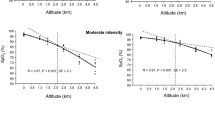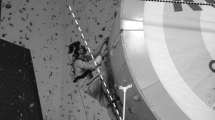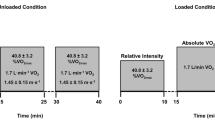Summary
There are conflicting reports in the literature which imply that the decrement in maximal aerobic power experienced by a sea-level (SL) resident sojourning at high altitude (HA) is either smaller or larger for the more aerobically “fit” person. In the present study, data collected during several investigations conducted at an altitude of 4300 m were analyzed to determine if the level of aerobic fitness influenced the decrement in maximal oxygen uptake \(\dot V_{O_{2\max } } \) at HA. The \(\dot V_{O_{2\max } } \) of 51 male SL residents was measured at an altitude of 50 m and again at 4300 m. The subjects' ages, heights, and weights (mean ± SE) were 22±1 yr, 177±7 cm and 78±2kg, respectively. The subjects' \(\dot V_{O_{2\max } } \) ranged from 36 to 60 ml·kg−1·min−1 (mean ± SE=48±1) and the individual values were normally distributed within this range. Likewise, the decrement in \(\dot V_{O_{2\max } } \) at HA was normally distributed from 3 ml·kg−1·min−1 (9% \(\dot V_{O_{2\max } } \) at SL) to 29 ml·kg−1·min−1 (54% \(\dot V_{O_{2\max } } \) at SL), and averaged 13±1 ml·kg−1·min−1 (27±1% \(\dot V_{O_{2\max } } \) at SL). The linear correlation coefficient between aerobic fitness and the magnitude of the decrement in \(\dot V_{O_{2\max } } \) at HA expressed in absolute terms was r=0.56, or expressed as % \(\dot V_{O_{2\max } } \) at SL was r=0.30; both were statistically significant (p<0.05). Therefore, only 31 and 9%, respectively, of the variability in the decrement at HA could be attributed to the \(\dot V_{O_{2\max } } \) at SL. Thus, while the more aerobically fit individuals do tend to suffer a larger decrement in maximal aerobic power at altitude, the level of aerobic fitness per se accounts for a relatively small amount of the variability between individuals in this decrement.
Similar content being viewed by others
References
Balke B, Ware RW (1959) An experimental study of physical fitness of Air Force personnel. US Armed Forces Med J 10:675–688
Buskirk ER (1969) Decrease in physical working capacity at high altitude. In: Hegnauer AH (ed) Biomedicine problems of high terrestial elevations, US Army Research Institute of Environmental Medicine, Natick, MA, pp 204–222
Dempsey J, Hansen P, Mastenbrook M (1978) Imperfections in the response of the healthy pulmonary system to exercise. Med Sci Sports 10:43
Drinkwater BL, Horvath SM (1979) Heat intolerance and aging. Med Sci Sports 11:49–55
Grover RF, Reeves JT, Grover EB, Leathers JE (1967) Muscular exercise in young men native to 3100 m altitude. J Appl Physiol 22:555–564
Hartley LH (1971) Effects of high-altitude environment on the cardiovascular system of man. J Am Med Assoc 215:241–244
Horstman DH, Weiskopf R, Jackson RE (1980) Work capacity during a 3-week sojourn at 4300 m: effects of relative polycythemia. J Appl Physiol: Respirat Environ Exercise Physiol 49:311–318
Kamon E (1972) Cardiopulmonary responses of male and female subjects to submaximal work on laddermill and cycle ergometer. Ergonomics 15:25–32
Cote J, Dulac S, Dulong-Turcot F (1978) Effects of age, sex and physical fitness on responses to local cooling. J Appl Physiol: Respirat Environ Exercise Physiol 44:813–817
McArdle WS, Katch FI, Pechar GS (1973) Comparison of continuous and discontinuous treadmill and bicycle tests for \(\dot V_{O_{2\max } } \). Med Sci Sports 5:156–160
Saltin B (1967) Aerobic and anaerobic work capacity at an altitude of 2250 meters. In: Goddard RF (ed) The effects of altitude on physical performance. The Athletic Institute, Albuquerque, NM, pp 97–102
Saltin B, Grover RF, Blomquist CG, Hartley LH, Johnson RL Jr (1968) Maximal oxygen uptake and cardiac output after two weeks at 4300 m. J Appl Physiol 25:400–409
Snedecor GW, Cochran WG (1967) Statistical methods. Iowa State University Press, Ames, Iowa, pp 84–85 and pp 135–189
Squires RW, Buskirk ER (1982) Aerobic capacity during acute exposure to simulated altitude, 914 to 2286 meters. Med Sci Sports Exerc 14:36–40
Sue DU, Hansen JE, Blais M, Wasserman K (1980) Measurement and analysis of gas exchange during exercise using a programmable calculator. J Appl Physiol: Respirat Environ Exercise Physiol 49:456–461
Young AJ, Evans WJ, Cymerman A, Pandolf KB, Knapik JJ, Maher JT (1982) Sparing effect of chronic high-altitude exposure on muscle glycogen utilization. J Appl Physiol: Respirat Environ Exercise Physiol 52:857–862
Author information
Authors and Affiliations
Rights and permissions
About this article
Cite this article
Young, A.J., Cymerman, A. & Burse, R.L. The influence of cardiorespiratory fitness on the decrement in maximal aerobic power at high altitude. Europ. J. Appl. Physiol. 54, 12–15 (1985). https://doi.org/10.1007/BF00426291
Accepted:
Issue Date:
DOI: https://doi.org/10.1007/BF00426291




